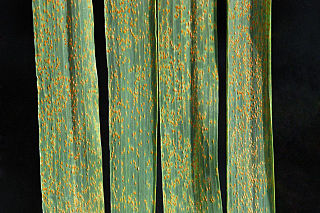
A heteroecious parasite is one that requires at least two hosts. The primary host is the host in which the parasite spends its adult life; the other is the secondary host. Both hosts are required for the parasite to complete its life cycle. This can be contrasted with an autoecious parasite which can complete its life cycle on a single host species. Many rust fungi have heteroecious life cycles:

Rusts are fungal plant pathogens of the order Pucciniales causing plant fungal diseases.

Stem rust, also known as cereal rust, black rust, red rust or red dust, is caused by the fungus Puccinia graminis, which causes significant disease in cereal crops. Crop species that are affected by the disease include bread wheat, durum wheat, barley and triticale. These diseases have affected cereal farming throughout history. The annual recurrence of stem rust of wheat in North Indian plains was discovered by K.C. Mehta. Since the 1950s, wheat strains bred to be resistant to stem rust have become available. Fungicides effective against stem rust are available as well.

Wheat leaf rust is a fungal disease that affects wheat, barley, rye stems, leaves and grains. In temperate zones it is destructive on winter wheat because the pathogen overwinters. Infections can lead up to 20% yield loss. The pathogen is a Puccinia rust fungus. It is the most prevalent of all the wheat rust diseases, occurring in most wheat-growing regions. It causes serious epidemics in North America, Mexico and South America and is a devastating seasonal disease in India. P. triticina is heteroecious, requiring two distinct hosts.

Puccinia hordei is a species of rust fungus. A plant pathogen, it can cause leaf rust of barley, also known as brown rust of barley. It was originally found on the dry leaves of Hordeum vulgare in Germany.
Puccinia striiformis is a fungal species and plant pathogen. It causes stripe rust on wheat, but has other hosts as well. The species is common in Europe and in more recent years has become a problem in Australia. Crop infections can cause losses of up to 40%, and the fungus will infect both winter wheat and spring wheat.

Puccinia aristidae is a plant pathogen that causes rust on Aristida, spinach and primula.

Puccinia dioicae is a plant pathogen that causes rust on goldenrod.

Puccinia pelargonii-zonalis is a fungal species and plant pathogen that causes rust on Pelargonium geraniums. It was originally found on the leaves of Pelargonium zonale in KwaZulu-Natal, South Africa.

Puccinia purpurea is a fungal species and plant pathogen that causes rust on sorghum. It is found in temperate places worldwide, excluding colder parts such as Russia and Canada.
Puccinia subnitens is a fungal species and plant pathogen that causes rust on Beta vulgaris. It was originally found on Distichlis spicata in Montana, USA.
Puccinia xanthii is a plant pathogen infecting sunflowers. It also causes rust on Xanthium occidentale and can be used as a form of biological control where this plant is an invasive species.
Puccinia pittieriana is a species of rust fungus. It is a plant pathogen which infects agricultural crops such as potato and tomato. Its common names include common potato rust and common potato and tomato rust.

Puccinia is a genus of fungi. All species in this genus are obligate plant pathogens and are known as rusts. The genus contains about 4000 species.

Puccinia malvacearum, also known as hollyhock or mallow rust, is a fungal species within the genus Puccinia known for attacking members of the family Malvaceae. An autoecious pathogen, it can complete its life cycle using a single host.

Puccinia sessilis is a fungal species and plant pathogen, which is also known as arum rust or ramsons rust. It commonly infects Arum maculatum and Allium ursinum causing yellow to orange circular patches on leaves. On the underside of the leaves, it produces raised orange aecia commonly covered in spores. It is common in Eurasia in the spring.

Puccinia oxalidis is a fungus species in the genus Puccinia. This species is a causal agent of rust on plants in the genus Oxalis, such as Oxalis articulata. The disease appears as yellow dots on the reverse of the leaves. The aecial stage can also be found on Berberis repens. It was originally found on Oxalis species in Mexico.

Puccinia cnici-oleracei is a plant pathogen that causes rust on species in the Asteraceae family.












